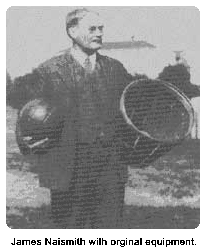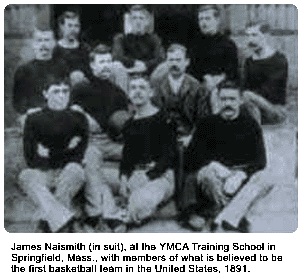Most sports fans know something about Dr. James A. Naismith, the inventor of basketball.
Here are a few tidbits that some may not be aware of, such as: Naismith was orphaned at age nine and reared in Canada — North America's ice hockey capital. After graduating from McGill University and Presbyterian College in Montreal, Naismith decided to seek a master's degree in physical education at what is now Springfield College in Springfield, Massachusetts.
Football in the fall and baseball in the spring were already established. What was needed, during harsh New England winters, was an indoor game for a P.E. class that could get unruly from an overdose of calisthenics and tumbling.
Dr. Luther Gulick, superintendent of the P.E. department, agreed. He gave Naismith and his class 14 days to come up with an indoor game that would challenge participants to use their noggins as well as their physical skills. It had to be easy to learn and play, and hold the students' interest.
Naismith tried a number of concepts that included modifying such existing outdoor sports as soccer and rugby to indoor conditions. Maybe there was a way to combine such other games as football, lacrosse, and a game that Naismith had played as a youth, called "Duck on a Rock." That game employed a small cobblestone, called a "Duck," to knock a similar-sized cobblestone, called a "Drake," from its place atop a larger stone.
 Naismith toyed with dribbling a football to a goal. That did not work out as well as a soccer ball, because carrying the ball was prohibited by one of 13 original rules* Naismith had proposed.
Naismith toyed with dribbling a football to a goal. That did not work out as well as a soccer ball, because carrying the ball was prohibited by one of 13 original rules* Naismith had proposed.
Next he asked the school janitor for a couple of boxes to use as goals, but all the janitor could come up with were two half-bushel peach baskets. Naismith tacked them to the edge of a running track encompassing the gymnasium 10 feet off the floor — the same height used today.
The ball had to be retrieved by someone on a ladder after each goal. Soon after, the bottoms were cut out, which sped up the game and increased the students' interest.
Naismith's class was composed of 18 students, some older than his 30 years. He divided the class into teams of nine with three forwards, three centers, and three backs. The soccer ball was tossed between two centers, and it was "game on." The year was 1891.
Naismith "Notabilia"
Aside from being the "Father of Basketball," Naismith became the first basketball coach at what is now recognized as a national college powerhouse — Kansas University. He also was the only Jayhawks coach to leave the school with a losing record, going 55-60 from 1898 to 1907 — 115 games in 10 seasons, 11.5 games a year, on average.
One of Naismith's proteges was destined to become one of the winningest and most revered of basketball coaches ever — Phog Allen.
Naismith's reaction to his dubious place at the bottom of the list of Kansas coaches was, "Basketball is a game to be played, not coached. For me, the game is about exercise and good-natured competition. I just never saw winning as important." His name is now emblazened on the floor of Phog Allen Fieldhouse in Lawrence.
Naismith once remarked that one of the happiest days of his life was when he got to attend the first international basketball game played on the Olympic Games stage in Berlin, in 1936.
Following the Olympics, with his name back in the news, he was offered anywhere from $75,000 to $500,000 for endorsements for various tobacco products, which he rejected on principle — tobacco was harmful to young people.
In a book published in 1995, Naismith was named fourth in a list of the top-100 most influential American sports figures of the century.
 Epilogue
Epilogue
Naismith went on to earn a medical degree from Gross Medical School in Colorado, which gave him four degrees in four fields of study. Added to previously mentioned awards, he received degrees in philosophy and religion.
He was never in the game of basketball for profit or fame, rather, teaching the game's fundamentals to anyone who would lend an ear. "Papa Jimmy," as his grandchildren called him, was the quintessential role model.